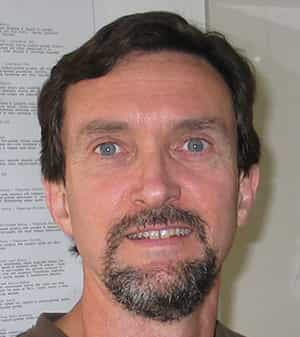Collecting Rocks
The Museum's Hall of Planet Earth displays over 100 rocks. Each rock tells vital stories about how Earth evolved. Jim was part of the team that collected these rocks from around the world. Near the Grand Canyon, they made casts of sedimentary layers to show how scientists can "read" rocks to learn about Earth's history. In Hawaii, they made a cast of a lava tree, a tree-shaped "shell" left behind when lava engulfs a tree, hardens around it, and causes the tree to burn away. It shows how volcanoes help form mountains, continents, and ocean basins. In Colorado, they collected a large granite boulder from a mine. It shows how minerals used by people, like salt, are formed in Earth's crust. In Indonesia, they collected large boulders of sulfur from an active, explosive volcano. The rocks formed from gases released from hot magma below the surface. In the ancient Roman city of Pompeii, they made a cast of a fallen column of bricks to show the destructive power of explosive volcanoes. Now, people can study them up close and learn how geologists read the Earth's "history book."
Name: Jim Webster
Hometown: Cartersville, Georgia
Education: Ph.D., Arizona State University
Job: Curator, Earth & Planetary Sciences at the American Museum of Natural History
Known for: creating artificial volcanoes in the lab
Cool fact: When Jim's team visited Mount St. Augustine, they hiked up the volcano and then slid down the snowy slopes on their backs.

Jim studies the gases that are released during explosive volcanic eruptions. One of these gases is:
helium
lava
sulfur
Correct!
Volcanoes release many gases, including sulfur. In Indonesia Jim collected a large boulder of pure sulfur. The boulder had formed from gases released from hot magma.
Both in the field and in the lab, Jim Webster studies rocks that form when magma cools in the Earth or on the surface. These are:
igneous rocks
metamorphic rocks
sedimentary rocks
Correct!
Jim collects igneous rocks called pumices. These rocks form from the foamy, gas-filled lava produced during explosive eruptions. Pumice looks like puffed sponges and actually floats in water.
Jim has seen many erupting volcanoes.
Fiction
Although Jim has traveled around the globe to study and collect samples from volcanoes, he has never seen one erupt explosively. But he hopes to one day!
Jim makes rocks in the lab.
Fact
To make rocks in the lab, Jim first crushes up volcanic rocks and adds water and gases. Then he uses special equipment to put these samples under extreme heat and pressure, the same conditions as those deep inside the Earth's crust.
Volcanoes and earthquakes don't occur in random places. They mostly occur at plate tectonic boundaries. If you live in the middle of a tectonic plate, like New York, you can feel safe that the Earth won't shake.

Jim Webster, Earth scientist




 Biodiversity
Biodiversity
 Brain
Brain
 Genetics
Genetics
 Marine BiOLogy
Marine BiOLogy
 MicrobiOLogy
MicrobiOLogy
 PaleontOLogy
PaleontOLogy
 ZoOLogy
ZoOLogy
 AnthropOLogy
AnthropOLogy
 ArchaeOLogy
ArchaeOLogy
 Astronomy
Astronomy
 Climate Change
Climate Change
 Earth
Earth
 Physics
Physics
 Water
Water
